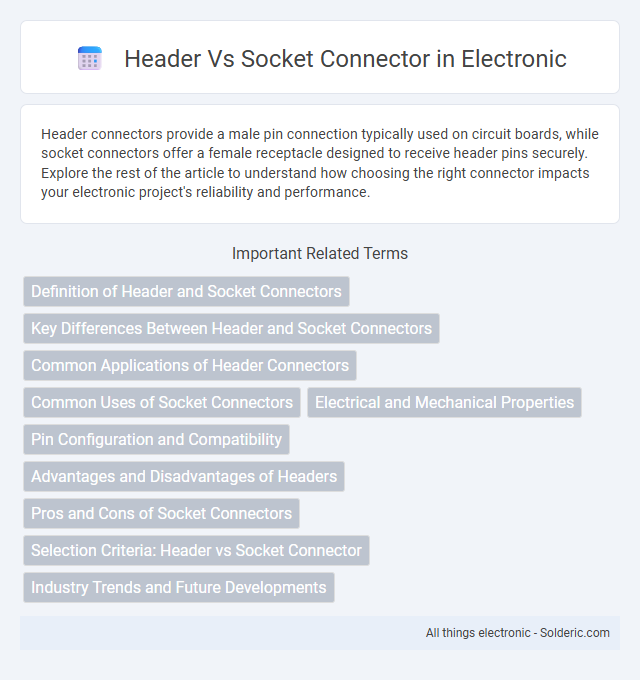Header connectors provide a male pin connection typically used on circuit boards, while socket connectors offer a female receptacle designed to receive header pins securely. Explore the rest of the article to understand how choosing the right connector impacts your electronic project's reliability and performance.
Comparison Table
| Feature | Header Connector | Socket Connector |
|---|---|---|
| Definition | Pin-based male connector | Receptacle female connector |
| Function | Provides pins for connection | Houses pins for receiving connection |
| Common Use | Board-to-wire or board-to-board connections | Wire-to-board or board-to-board interfaces |
| Durability | Durable, exposed pins prone to bending | Protective housing, reduces pin damage |
| Installation | Soldered to PCB, easy to insert pins | Soldered or press-fit, accepts header pins |
| Ease of Replacement | Less flexible, pins can bend | More flexible, simple unplugging |
| Typical Applications | Motherboards, expansion cards | Cable harnesses, modular connections |
| Connector Type | Male | Female |
Definition of Header and Socket Connectors
Header connectors consist of a row or array of male pins mounted on a printed circuit board (PCB) or a plastic housing, designed to interface with corresponding socket connectors. Socket connectors contain female contacts built to receive and secure the pins from header connectors, enabling reliable electrical connections between PCBs or cables. Both connectors are essential components in electronic assemblies for modular and removable connections in devices.
Key Differences Between Header and Socket Connectors
Header connectors consist of a row or rows of male pins, typically mounted on printed circuit boards (PCBs), providing a stable interface for connections. Socket connectors feature female receptacles designed to mate with header pins, allowing easy insertion and removal for modular component connections. The primary differences lie in their structural design and function: headers offer fixed pin configurations, while sockets facilitate flexible and replaceable connections, impacting assembly and maintenance in electronic devices.
Common Applications of Header Connectors
Header connectors are widely used in electronics for board-to-board, wire-to-board, and cable-to-board connections, commonly found in computer motherboards, industrial equipment, and consumer electronics. Their versatile pin configurations and reliable mating make them ideal for signal and power transmission in embedded systems and modular designs. You can rely on header connectors for applications requiring compact, secure, and easy-to-install connections in a variety of electronic assemblies.
Common Uses of Socket Connectors
Socket connectors are commonly used in electronic devices to provide secure and removable connections for integrated circuits, such as CPUs, memory modules, and microcontrollers. They facilitate easy replacement, upgrading, and maintenance by allowing components to be plugged in and unplugged without soldering. Common applications include computer motherboards, embedded systems, and modular hardware assemblies where frequent component swaps or repairs are necessary.
Electrical and Mechanical Properties
Header connectors typically feature rigid pins providing robust electrical conductivity and mechanical stability, making them ideal for consistent signal transmission and durable mating cycles. Socket connectors offer spring-loaded contacts that ensure reliable electrical connections even under vibration or slight misalignment, enhancing mechanical flexibility and maintaining signal integrity. Choosing between them depends on your application's need for either firm mechanical support or adaptable, vibration-resistant connectivity.
Pin Configuration and Compatibility
Header and socket connectors differ primarily in pin configuration and compatibility; headers feature protruding pins arranged in single or dual rows, designed to plug into corresponding sockets with matching female contacts. Proper alignment and pin count are essential to ensure electrical and mechanical compatibility, preventing misconnection or damage. Selecting compatible connectors ensures that your electronic components interface correctly for reliable signal and power transmission.
Advantages and Disadvantages of Headers
Headers offer easy and reliable connection points for PCB components, enabling straightforward soldering and strong mechanical stability. Their fixed pin arrangement simplifies design and assembly but can limit flexibility in complex circuits due to fixed spacing and size constraints. However, headers can be prone to damage if subjected to repeated mating cycles, and connectors may require careful alignment to avoid bent pins.
Pros and Cons of Socket Connectors
Socket connectors offer secure and reliable connections with easy component replacement, reducing maintenance time and minimizing damage risk during disassembly. However, they tend to be bulkier and more expensive compared to header connectors, potentially limiting space efficiency in compact electronic designs. Their complexity can also result in higher manufacturing costs and require precise alignment for optimal electrical performance.
Selection Criteria: Header vs Socket Connector
Selecting between header and socket connectors depends primarily on the application's mechanical durability and connection flexibility requirements. Headers provide a fixed, robust interface ideal for permanent PCB mounting, while sockets offer removable, reusable connections suitable for easy component replacement or prototyping. Key factors include pitch size compatibility, current rating, and environmental conditions affecting connector longevity.
Industry Trends and Future Developments
Header and socket connectors are evolving rapidly due to increasing demands for miniaturization, higher data transfer speeds, and enhanced reliability in industries like automotive, aerospace, and consumer electronics. Innovations such as high-density designs, improved materials for corrosion resistance, and integrated smart sensors are shaping future developments. Your choice of connectors will benefit from advancements that prioritize signal integrity, ease of assembly, and scalability in increasingly complex electronic systems.
Header vs Socket connector Infographic

 solderic.com
solderic.com